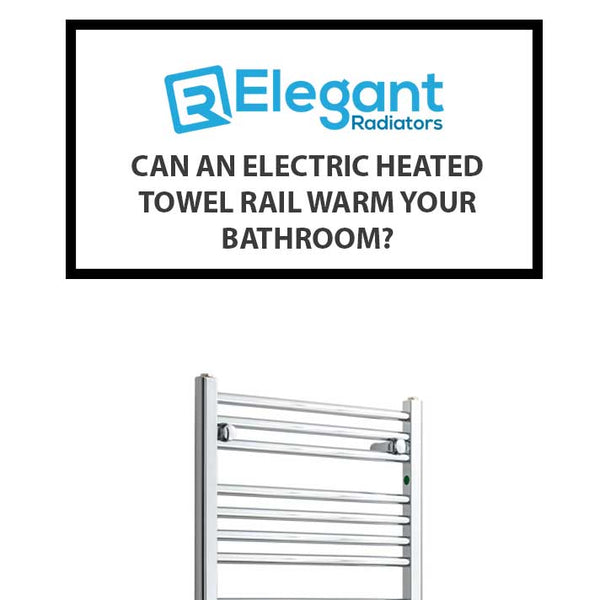Can an Electric Heated Towel Rail Warm Your Bathroom?
Electric heated towel rails are renowned for providing the simple, year-round luxury of warm, dry towels. They are stylish, convenient, and wonderfully independent from your central heating system. But many homeowners considering an all-electric solution for their bathroom have a crucial question: are they just for towels, or can an electric towel rail actually be powerful enough to be the sole source of heat for the entire room?

The answer is a resounding yes, an electric towel rail can absolutely heat a whole bathroom, and do so very effectively. However, this comes with one critical condition: you must choose a model with the correct heat output for the size and characteristics of your specific room. The common mistake is to choose a rail based on its physical dimensions alone, without considering its power.
This expert guide from Elegant Radiators will walk you through the simple process of calculating your bathroom's heating requirement, ensuring you can confidently select an electric towel rail that will keep both your towels and your space perfectly warm, even on the coldest winter mornings.
It's All About Power: Understanding Watts and Heat Output
First, it's important to separate the two jobs of a towel rail: warming towels and heating a room. Some smaller, low-power "warming rails" (e.g., 100-150W) are designed only for the first task. To effectively heat an entire room, you need a proper heated towel rail with a substantial power output.
The heating power of an electric appliance is measured in Watts (W). The higher the wattage of the heating element inside the towel rail, the more heat it can produce. The goal is to match the wattage of your towel rail to the heat that is naturally lost from your bathroom through its walls, window, and ceiling. If your rail puts out more heat than the room loses, the room will warm up.
The Key to Success: Calculating Your Bathroom's Heat Requirement
So, how many Watts do you need? You can find out with a simple, three-step calculation. For our example, let's use a common UK bathroom size of 2.5m long by 2m wide.
Step 1: Calculate Your Room's Volume (m³)
You need to heat the volume of air in the room, so first, we calculate this.
Formula: Length (m) x Width (m) x Height (m) = Room Volume (m³)
Assuming a standard UK ceiling height of 2.4 metres:
Example Calculation: 2.5m x 2.0m x 2.4m = 12m³
Step 2: Apply the Bathroom Heat Multiplier
Different rooms require different amounts of heat. Because you want a bathroom to feel comfortably warm when you step out of the shower, it needs a higher power input than, say, a bedroom. A standard industry guide for a well-insulated modern UK home is:
- For Bathrooms: A multiplier of around 60 Watts per cubic metre (W/m³) is recommended.
- (For comparison, a living room might only need 50W/m³ and a bedroom 40W/m³).
Step 3: Calculate Your Required Wattage
Now, simply multiply your room's volume by the bathroom heat multiplier.
Formula: Room Volume (m³) x 60W = Required Heat Output (W)
Example Calculation: 12m³ x 60W = 720 Watts
The Verdict: Choosing the Right Electric Towel Rail
The calculation gives us a clear answer. To comfortably heat our example 2.5m x 2m bathroom and also dry towels effectively, you should look for an electric towel rail with a power output of at least 700-750 Watts.
With this knowledge, you can now browse the Company Blue website with confidence. On every electric towel rail product page, the "Specification" section will clearly state the power of the heating element in Watts. Simply choose a model that meets or slightly exceeds your calculated requirement.
This is why a tiny 150W rail won't heat the room it's not designed to. But a substantial 800W vertical towel rail absolutely will, and very effectively. The key is to match the power to the space. Once you have your target wattage, you can then choose the physical shape be it a tall, narrow model or a shorter, wider one that best fits your wall.
Factors That Help Your Towel Rail Heat the Room More Effectively
- Good Insulation: A bathroom with good loft insulation above it and double-glazed windows will lose heat much more slowly, making your towel rail's job easier and more efficient.
- Lot 20 Controls: A modern, Lot 20 compliant towel rail has a precise digital thermostat. This is essential for maintaining a stable, comfortable room temperature without wasting electricity.
- Material and Finish: Towel rails with a painted finish (like anthracite or white) are slightly more emissive than chrome, meaning they are a little more effective at radiating their heat out into the room.
FAQ: Electric Towel Rails for Room Heating
Here are our answers to some common questions about using your electric rail as a primary heat source.
What happens if I choose a towel rail with too low a wattage?
An underpowered towel rail will still do a great job of warming the towels placed directly on it. However, on a cold day, it will struggle to raise the overall temperature of the bathroom to a comfortable level. It may have to run constantly without ever reaching the thermostat's target, which is an inefficient use of electricity.
Is a fluid-filled or a 'dry heat' electric rail better for heating a whole room?
Both can be effective if correctly sized. However, a fluid-filled model is often considered better for providing a consistent, comfortable ambient room temperature. This is because the hot fluid retains heat well, continuing to radiate warmth even when the thermostat has temporarily switched the element off, creating a more stable heating experience.
Will hanging towels on the rail stop it from heating the room?
Yes, to an extent. A thick, heavy towel will act as an insulator, absorbing a lot of the heat and preventing it from radiating out into the room. This is why it's a good idea to choose a towel rail that slightly exceeds your calculated wattage requirement. This ensures it has enough power to both dry your towels and keep the room warm simultaneously.
Is it more expensive to heat a bathroom with electricity than central heating?
Hour-for-hour, the running cost is higher due to the unit price of electricity being more than gas. However, the true economy of an electric rail comes from its intelligent control. The ability to use a timer to heat just one room for a short period is far more efficient in practice than firing up a large central heating boiler just for the bathroom. For on-demand and targeted heating, it is a very economical solution.
For a very large or poorly insulated bathroom, what is the best solution?
For a very large bathroom (e.g., over 10m²), relying on a single towel rail can be a challenge. In this scenario, the "best of both worlds" approach is often ideal: install a powerful, correctly-sized standard radiator (either central heating or electric) to act as the primary source of room heat, and supplement this with a separate, stylish heated towel rail purely for the luxury of warming and drying towels.







